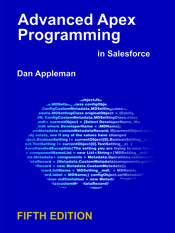In my book Advanced Apex Programming, I spend quite a bit of time discussing trigger design patterns. But I’m going to let you in on a little secret – what you find in the book isn’t really a “design pattern”, so much as a design concept.
And despite the chapter name “One trigger to rule them all”, I didn’t originate the idea that it was a good idea to control execution sequence by using just one trigger – experienced Apex developers already knew this. What I think I brought to the table was the idea that we could take advantage of the Apex language object oriented features to implement that concept in some really good, supportable and reliable ways.
Here’s a secret – the examples I used in the book do not, in fact, accurately reflect the framework I used in our own products. The framework we use is considerably more sophisticated. But the examples do reflect the concepts that our framework uses.
I did this because I do not believe there is any one “right” trigger design pattern or framework for everyone and every situation. So my goal in the book was to demonstrate the concepts involved, in the hope that others would build on it – come up with variations of different design patterns and frameworks based on those concepts.
I was thrilled to see the other day a blog post by Hari Krishnan called “An architecture framework to handle triggers in the Force.com platform”. It’s beautiful piece of work (and I do appreciate the shout out). As with our own framework, I don’t think it’s a solution for every scenario, but it does present a very elegant object oriented implementation to the problem. What really struck me was the innovative use of dynamic typing to instantiate objects based on the object type and name. Our own framework doesn’t use that approach, for the obvious reason that it was built before Apex supported dynamic object creation by type, but it’s definitely worth considering for any design going forward.
I don’t know if Hari has worked on the .NET platform (he does mention Java and C#), but the idea of dispatching by name is one we’ve seen in a number of Microsoft frameworks and languages. One can’t help but wonder if, now that we have a real tooling API, someone might come up with a client tool to generate and manage trigger handlers based on a framework like this….
Not only might this automate some of the “plumbing”, but conceivably bring us to that state of Nirvana where, with judicious use of some global interfaces, we might be able to control order of trigger execution across cooperating packages and between packages and Apex code on an organization instance.
Ah well, one can dream. Meanwhile, kudos to Hari for a fine piece of work. Definitely worth a read.


Dan,
Thanks for your kind words. I indeed have a strong background on .NET and Java and I think that helped when I came up with this framework.
I believe there is a huge potential with the tooling API and if it is released that will have a tremendous impact in the way we develop force.com applications. There will be still gaping holes for e.g. the inability of live debugging, one day Salesforce might come with a solution for that as well (for e.g. a private instance of sandbox for each developer – I don’t think it is possible in the near term, but as the technology improves, it might be possible one day).